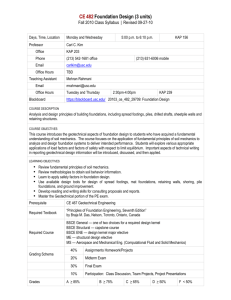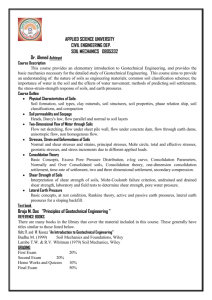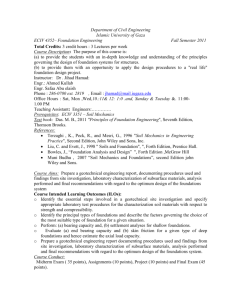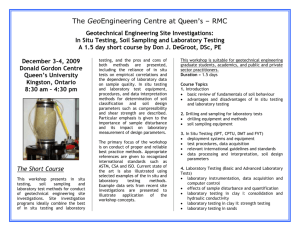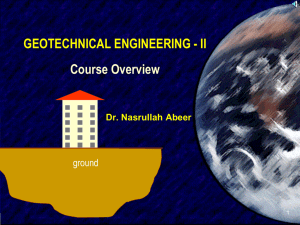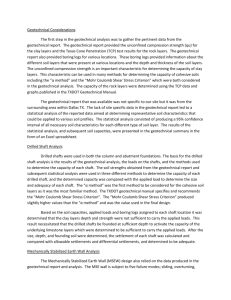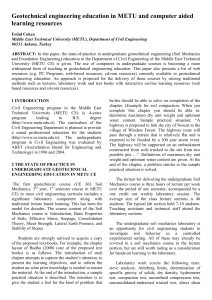Geotechnical Engineering
advertisement
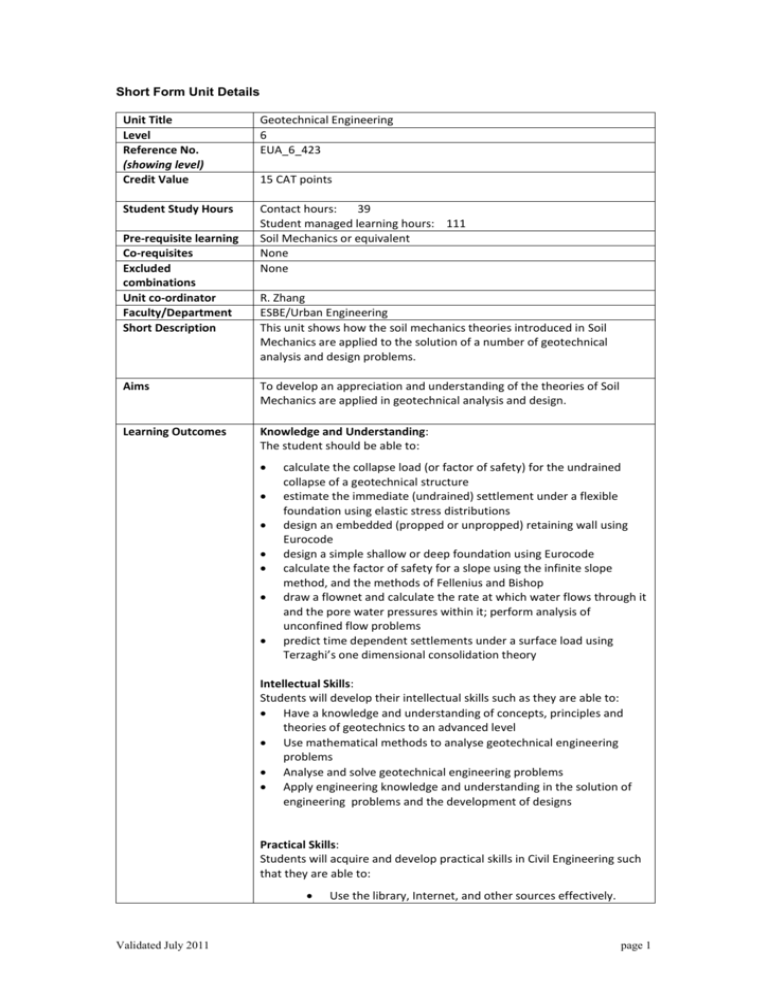
Short Form Unit Details Unit Title Level Reference No. (showing level) Credit Value Geotechnical Engineering 6 EUA_6_423 Student Study Hours Contact hours: 39 Student managed learning hours: 111 Soil Mechanics or equivalent None None Pre-requisite learning Co-requisites Excluded combinations Unit co-ordinator Faculty/Department Short Description 15 CAT points R. Zhang ESBE/Urban Engineering This unit shows how the soil mechanics theories introduced in Soil Mechanics are applied to the solution of a number of geotechnical analysis and design problems. Aims To develop an appreciation and understanding of the theories of Soil Mechanics are applied in geotechnical analysis and design. Learning Outcomes Knowledge and Understanding: The student should be able to: calculate the collapse load (or factor of safety) for the undrained collapse of a geotechnical structure estimate the immediate (undrained) settlement under a flexible foundation using elastic stress distributions design an embedded (propped or unpropped) retaining wall using Eurocode design a simple shallow or deep foundation using Eurocode calculate the factor of safety for a slope using the infinite slope method, and the methods of Fellenius and Bishop draw a flownet and calculate the rate at which water flows through it and the pore water pressures within it; perform analysis of unconfined flow problems predict time dependent settlements under a surface load using Terzaghi’s one dimensional consolidation theory Intellectual Skills: Students will develop their intellectual skills such as they are able to: Have a knowledge and understanding of concepts, principles and theories of geotechnics to an advanced level Use mathematical methods to analyse geotechnical engineering problems Analyse and solve geotechnical engineering problems Apply engineering knowledge and understanding in the solution of engineering problems and the development of designs Practical Skills: Students will acquire and develop practical skills in Civil Engineering such that they are able to: Validated July 2011 Use the library, Internet, and other sources effectively. page 1 Use computer packages. Acquire some basic skills of geotechnical design Transferable Skills: apply mathematical skills manage time and work to deadlines Employability Teaching and learning pattern Indicative content This unit will provide the student with a good knowledge and understanding of the application of soil mechanics to geotechnical analysis and design, which is of paramount importance in any field of civil engineering. This will enable the student to gain important theoretical and practical professional skills essential for the student’s future work either in construction or design industry as well as organisations and agencies in which civil engineers may be employed. Lectures and tutorials supplemented by handouts. Plastic collapse methods Theory of plasticity. Collapse loads and factor of safety. Upper and lower bounds on collapse loads. Application to foundations, slopes and retaining walls. Groundwater flow Definition of total head. Darcy's Law. Flownets for confined and unconfined steady flow. Solutions for seepage through embankment dams. Groundwater and geotechnical design. Simple foundation design Bearing capacity factors for shallow foundations. Influence of water. Piles. Retaining walls: earth pressure theory Active and passive earth pressure coefficients. Design of unpropped and singly propped cantilever walls using Eurocode. Influence of water. Slope Stability Infinite slope solutions. Limit equilibrium solutions (Swedish & Bishop's Routine Method). Influence of water. Soil Deformations Overview of soil deformation theories. Elasticity. Standard solutions for stresses and settlements (Boussinesq, plane strip load, flexible foundations of different plan shapes, use of Fadum's chart). Terzaghi's one dimensional consolidation theory and its use in calculating settlements in design. Assessment Elements & weightings The unit is assessed by a combination of examination and coursework with the proportion of marks allocated to each component given below: Indicative Sources (Reading lists) Validated July 2011 Examination : 70% Coursework: 30% Individual feedback will be provided to students in all coursework submitted Atkinson, J.H., An Introduction to the Mechanics of Soils and Foundations, Mc-Graw-Hill, London, 1993. page 2 Powrie, W., Soil Mechanics: Concepts and Applications, Spon, 2004 (2nd ed). Barnes, G. Soil Mechanics: Principles and Practice. 3rd Ed. Palgrave, 2010. Budhu, M., Soil Mechanics and Foundations, 3rd Ed. Wiley, 2010. Aysen, A. (2005) Soil Mechanics, Basic Concepts and Engineering Applications, Taylor and Francis Craig, R.F., Soil Mechanics, Chapman Hall, London, 2004 (7th ed). Liu, C. & Evett, J.B., Soils and Foundations, Prentice Hall, 2001 (6th ed). McCarthy, D.F., Essentials of Soil Mechanics and Foundations: Basic Geotechnics, Prentice Hall, 1998 (5th ed) Whitlow, R., Basic Soil Mechanics, Prentice Hall, 2001 (4th ed). Caduto, D.P., Yeung M.R, and Kitch, WA, Geotechnical Engineering, Principles and Practice (2nd Ed) Pearson McCarthy D.F., Essentials of Soil Mechanics and Foundations: Basic Geotechnics, Prentice Hall, 1998 (5th ed). Holtz and Kovacs, An Introduction to Geotechnical Engineering, Prentice, 1981 Background Simons, N. E. and Menzies, B. K., A Short Course in Foundation Engineering, IPC Press, 2000 (2nd ed). Reddi, Seepage in Soils, Wiley, 2003 Validated July 2011 page 3

